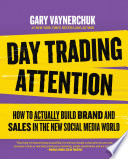

The book dives deep into the concept of the attention economy, where human attention is treated as a scarce resource. In today's digital landscape, businesses compete fiercely for consumer attention, making it a valuable commodity. The author explains how traditional metrics of success are being replaced by attention-based metrics, emphasizing the need for businesses to understand and leverage attention as a currency. This idea highlights the importance of creating engaging content and experiences that capture and retain attention. It also discusses the psychological aspects of attention, including how distractions can derail focus and productivity, and the strategies to combat these challenges.
Continue readingThe book outlines various strategies for capturing attention in a crowded marketplace. These strategies include leveraging storytelling, creating emotional connections, and utilizing visual elements to enhance engagement. The author emphasizes the role of authenticity and transparency in building trust with consumers. Additionally, the book discusses the importance of understanding audience demographics and psychographics to tailor messages effectively. By employing these strategies, businesses can not only capture attention but also convert it into meaningful interactions that drive loyalty and sales.
Continue readingTechnology plays a critical role in managing and directing attention. The book explores how various technological tools, such as social media platforms, algorithms, and artificial intelligence, are designed to maximize engagement. It discusses the implications of these technologies on consumer behavior and attention spans. The author also raises ethical concerns regarding attention manipulation and the responsibility of tech companies in fostering healthy engagement. This idea encourages readers to critically evaluate the technologies they use and their impact on personal and societal attention.
Continue readingThe author advocates for the development of business models that prioritize attention as a core component. This includes rethinking revenue streams to focus on attention-based metrics rather than traditional sales figures. The book provides case studies of companies that have successfully implemented attention-driven strategies, showcasing how they have adapted to the changing landscape. It encourages entrepreneurs to innovate their business models to thrive in the attention economy and emphasizes the need for continuous adaptation and learning.
Continue readingUnderstanding the psychology behind attention is crucial for anyone looking to succeed in the attention economy. The book delves into cognitive biases, the impact of multitasking, and the science of distraction. It explains how attention works on a neurological level and how marketers can leverage this knowledge to create more effective campaigns. The author discusses techniques to improve focus and concentration, both personally and professionally, which is essential for anyone looking to enhance their productivity and engagement.
Continue readingAs businesses strive to capture attention, ethical considerations become paramount. The book discusses the fine line between effective marketing and manipulation. It raises questions about the responsibility of marketers and companies in using attention-grabbing tactics. The author calls for a more ethical approach to attention marketing, advocating for transparency and respect for consumer autonomy. This idea serves as a reminder that while attention is valuable, it should not come at the cost of ethical standards and consumer trust.
Continue readingThe book concludes with a look at future trends in the attention economy, predicting how emerging technologies and societal shifts will shape the landscape. It discusses the potential impact of virtual reality, augmented reality, and other immersive technologies on attention. The author also explores the role of generational changes in attention preferences and consumption patterns. This forward-looking perspective encourages readers to stay informed and adaptable, preparing them for the inevitable changes in how attention is valued and managed.
Continue reading